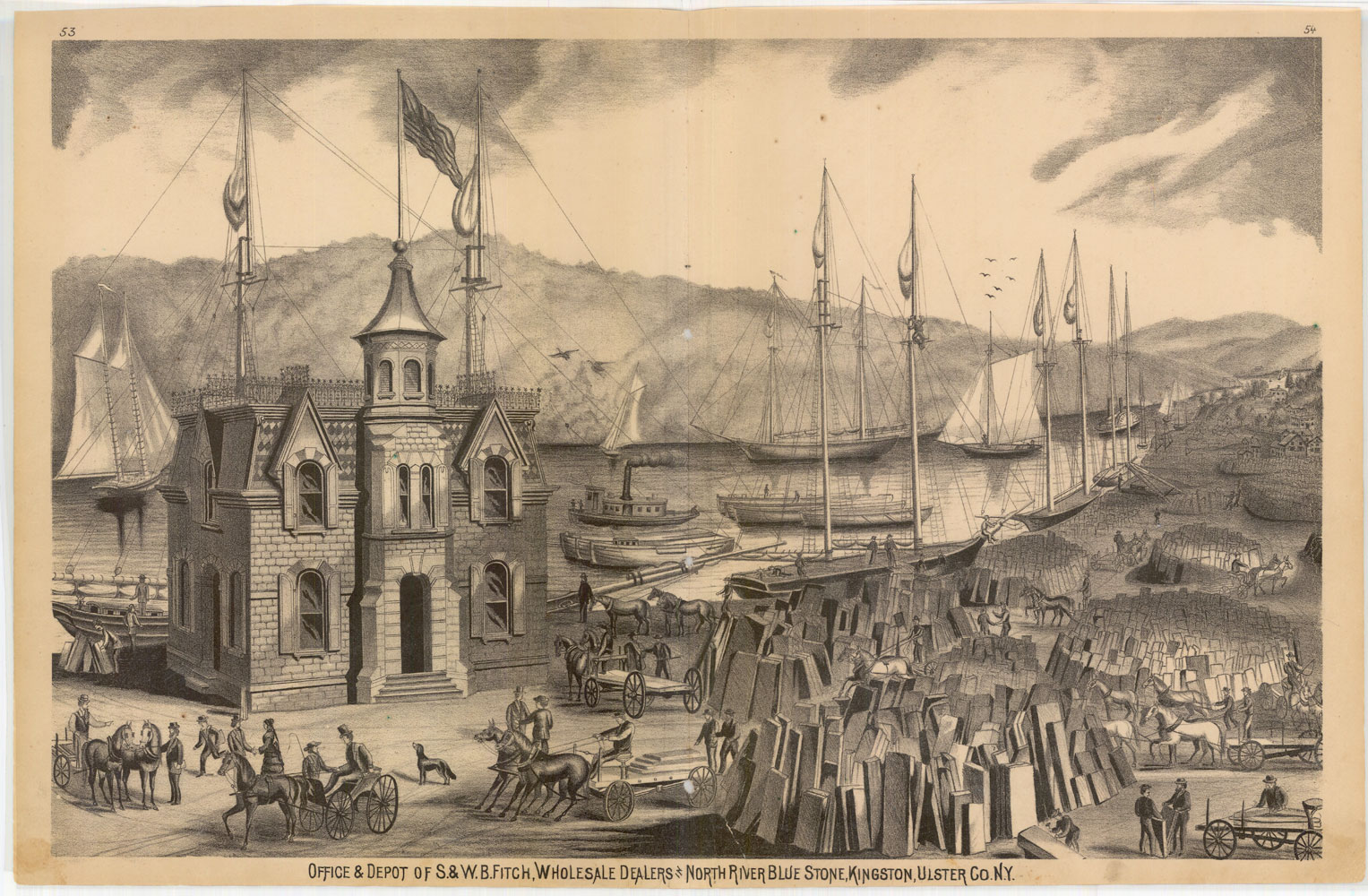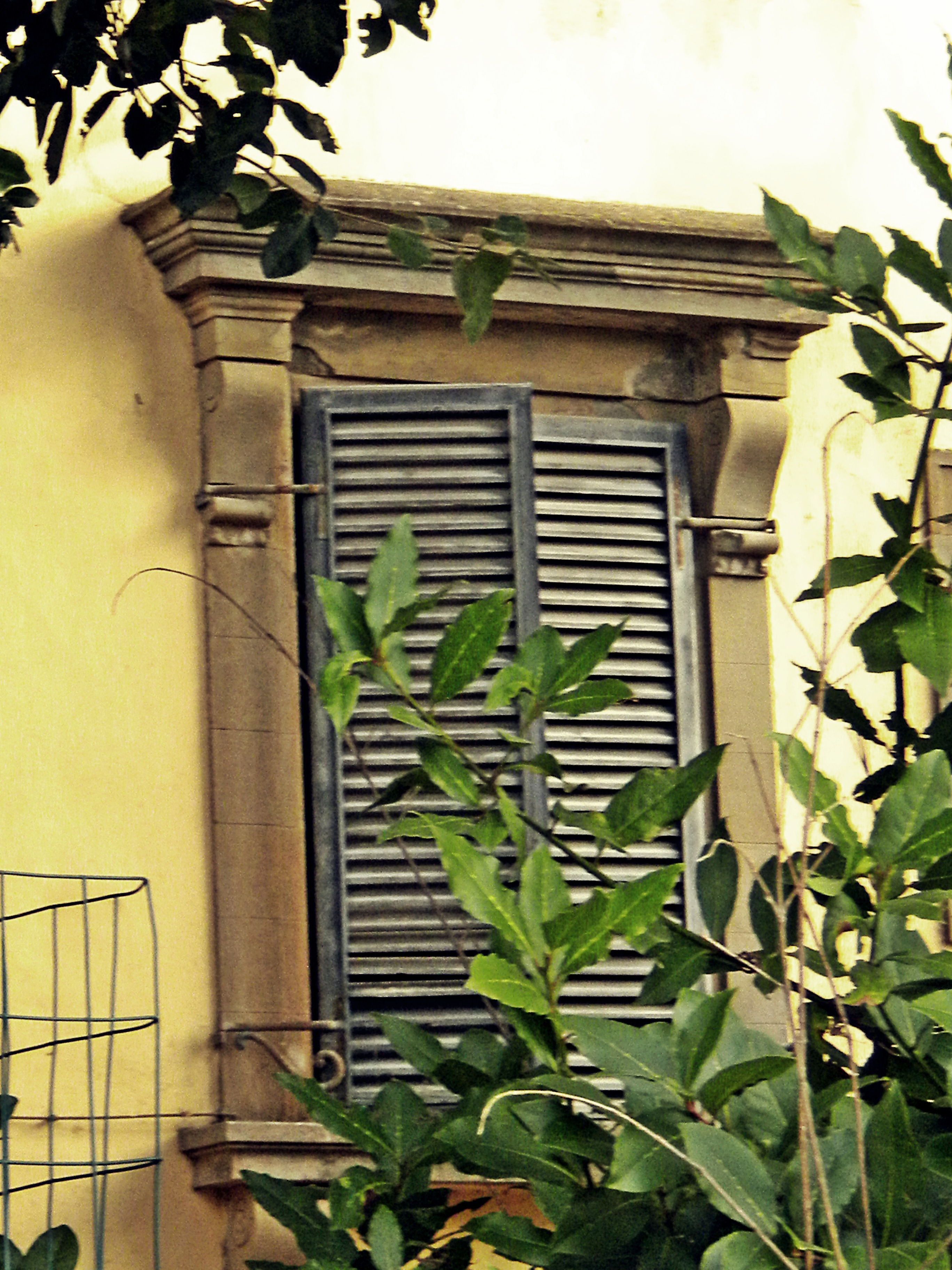|
Jacob Ten Broeck Stone House
The Jacob Ten Broeck Stone House is located on Albany Avenue (NY 32) in Kingston, New York, United States. It is a stone house built in the early years of the 19th century and modified later in that century. It is one of the rare high-style Federal homes in the city. In 2002 it was listed on the National Register of Historic Places. Building The house is on the north side of Albany Avenue, a short distance west of where it curves to the northeast. The neighborhood is mostly residential, with the exception of the Sharp Burial Ground, also listed on the National Register, slightly to the south on the opposite side of Albany. Most of the neighboring houses are of mid-19th to early 20th-century construction, on a large scale and frequently exhibiting little restraint in their architectural styles. The house at 184 Albany Avenue, a short distance across the street to the north, has been listed on the Register as well. In contrast to those other houses, which are on narrow, deep ... [...More Info...] [...Related Items...] OR: [Wikipedia] [Google] [Baidu] |
Kingston, New York
Kingston is the only Administrative divisions of New York#City, city in, and the county seat of, Ulster County, New York, United States. It is north of New York City and south of Albany, New York, Albany. The city's metropolitan area is grouped with the New York metropolitan area around Manhattan by the United States Census Bureau. The population was 24,069 at the 2020 United States census. Kingston became New York's first capital in 1777. During the American Revolutionary War, the city Burning of Kingston, was burned by the British on October 13, 1777, after the Battles of Saratoga. In the 19th century, it became an important transport hub after the discovery of Rosendale cement, natural cement in the region. It had connections to other markets through both the railroad and canal connections. Many of the older buildings are considered contributing as part of three historic districts, including the Kingston Stockade District, Stockade District uptown, the Midtown Neighborhoo ... [...More Info...] [...Related Items...] OR: [Wikipedia] [Google] [Baidu] |
Course (architecture)
A course is a layer of the same unit running horizontally in a wall. It can also be defined as a continuous row of any masonry unit such as bricks, concrete masonry units (CMU), stone, shingles, tiles, etc. Coursed masonry construction arranges units in regular courses. Oppositely, coursed rubble masonry construction uses random uncut units, infilled with mortar or smaller stones. If a course is the horizontal arrangement, then a wythe is a continuous vertical section of masonry one unit in thickness. A wythe may be independent of, or interlocked with, the adjoining wythe(s). A single wythe of brick that is not structural in nature is referred to as a masonry veneer. A standard 8-inch CMU block is exactly equal to three courses of brick. A bond (or bonding) pattern) is the arrangement of several courses of brickwork. The corners of a masonry wall are built first, then the spaces between them are filled by the remaining courses. Orientations Masonry coursing can be arrange ... [...More Info...] [...Related Items...] OR: [Wikipedia] [Google] [Baidu] |
Balustrade
A baluster () is an upright support, often a vertical moulded shaft, square, or lathe-turned form found in stairways, parapets, and other architectural features. In furniture construction it is known as a spindle. Common materials used in its construction are wood, stone, and less frequently metal and ceramic. A group of balusters supporting a guard railing, coping, or ornamental detail is known as a balustrade. The term baluster shaft is used to describe forms such as a candlestick, upright furniture support, and the stem of a brass chandelier. The term banister (also bannister) refers to a baluster or to the system of balusters and handrail of a stairway. It may be used to include its supporting structures, such as a supporting newel post. In the UK, there are different height requirements for domestic and commercial balustrades, as outlined in Approved Document K. Etymology According to the ''Oxford English Dictionary'', "baluster" is derived through the , from , from ' ... [...More Info...] [...Related Items...] OR: [Wikipedia] [Google] [Baidu] |
Newel
A newel, also called a central pole or support column, is the central supporting pillar around which a helical staircase winds. It can also refer to an upright post that supports or terminates the handrail of a stair banister (the "newel post"). In stairs having straight flights, it is the principal post at the foot of the staircase, but the term can also be used for the intermediate posts on landings and at the top of a staircase. Although its primary purpose is structural, newels have long been adorned with decorative trim and designed in different architectural styles. Newel posts turned on a lathe are solid pieces that can be highly decorative, and they typically need to be fixed to a square newel base for installation. These are sometimes called solid newels in distinction from hollow newels due to varying techniques of construction. Hollow newels are known more accurately as box newel posts. In historic homes, folklore holds that the house plans were placed in the newel u ... [...More Info...] [...Related Items...] OR: [Wikipedia] [Google] [Baidu] |
Turning (woodworking)
Woodturning is the craft of using a wood lathe with hand-held tools to cut a shape that is symmetrical around the axis of rotation. Like the potter's wheel, the wood lathe is a mechanism that can generate a variety of forms. The operator is known as a ''turner'', and the skills needed to use the tools were traditionally known as ''turnery''. In pre-industrial England, these skills were sufficiently difficult to be known as "the mysteries of the turners' guild." The skills to use the tools by hand, without a fixed point of contact with the wood, distinguish woodturning and the wood lathe from the machinist's lathe, or metal-working lathe. Items made on the lathe include tool handles, candlesticks, egg cups, knobs, lamps, rolling pins, cylindrical boxes, Christmas ornaments, bodkins, knitting needles, needle cases, thimbles, pens, chessmen, spinning tops; legs, spindles, and pegs for furniture; balusters and newel posts for architecture; baseball bats, hollow forms such as w ... [...More Info...] [...Related Items...] OR: [Wikipedia] [Google] [Baidu] |
Transom (architectural)
In architecture, a transom is a transverse horizontal structural beam or bar, or a crosspiece separating a door from a window above it. This contrasts with a mullion, a vertical structural member. Transom or transom window is also the customary American English, U.S. word used for a transom light, the window over this crosspiece. In British English, Britain, the transom light is usually referred to as a fanlight, often with a semi-circular shape, especially when the window is segmented like the slats of a folding hand fan. A prominent example of this is at the main entrance of 10 Downing Street, the official residence of the Prime Minister of the United Kingdom. History In Gothic architecture, early Gothic Church (building), ecclesiastical work, transoms are found only in belfry (architecture), belfry unglazed windows or spire lights, where they were deemed necessary to strengthen the mullions in the absence of the iron wiktionary:stay, stay bars, which in glazed windows served a ... [...More Info...] [...Related Items...] OR: [Wikipedia] [Google] [Baidu] |
Greek Revival Architecture
Greek Revival architecture is a architectural style, style that began in the middle of the 18th century but which particularly flourished in the late 18th and early 19th centuries, predominantly in northern Europe, the United States, and Canada, and Greece following that nation's independence in 1821. It revived many aspects of the forms and styles of ancient Greek architecture, including the Greek temple. A product of Hellenism (neoclassicism), Hellenism, Greek Revival architecture is looked upon as the last phase in the development of Neoclassical architecture, which was drawn from Roman architecture. The term was first used by Charles Robert Cockerell in a lecture he gave as an architecture professor at the Royal Academy of Arts in London in 1842. With newfound access to Greece and Turkey, or initially to the books produced by the few who had visited the sites, archaeologist–architects of the period studied the Doric order, Doric and Ionic order, Ionic orders. Despite its un ... [...More Info...] [...Related Items...] OR: [Wikipedia] [Google] [Baidu] |
Louver
A louver (American English) or louvre (Commonwealth English; American and British English spelling differences#-re, -er, see spelling differences) is a window blind or window shutter, shutter with horizontal wikt:slat, slats that are angled to admit light and air, but to keep out rain and direct sunshine. The angle of the slats may be adjustable, usually in blinds and windows, or fixed, such as in shutters. History Louvers originated in the Middle Ages as lantern-like constructions in wood that were fitted on top of roof holes in large kitchens to allow ventilation while keeping out rain and snow. They were originally rather crude constructions consisting merely of a barrel. Later, they evolved into more elaborate designs made of pottery, taking the shape of faces where the smoke and steam from cooking would pour out through the eyes and mouth, or into constructions that were more like modern louvers, with slats that could be opened or closed by pulling on a string. C ... [...More Info...] [...Related Items...] OR: [Wikipedia] [Google] [Baidu] |
Molding (decorative)
Moulding (British English), or molding (American English), also coving (in United Kingdom, Australia), is a strip of material with various profiles used to cover transitions between surfaces or for decoration. It is traditionally made from solid milled wood or plaster, but may be of plastic or reformed wood. In classical architecture and sculpture, the moulding is often carved in marble or other stones. In historic architecture, and some expensive modern buildings, it may be formed in place with plaster. A "plain" moulding has right-angled upper and lower edges. A "sprung" moulding has upper and lower edges that bevel towards its rear, allowing mounting between two non-parallel planes (such as a wall and a ceiling), with an open space behind. Mouldings may be decorated with paterae as long, uninterrupted elements may be boring for eyes. Types Decorative mouldings have been made of wood, stone and cement. Recently mouldings have been made of extruded polyvinyl chl ... [...More Info...] [...Related Items...] OR: [Wikipedia] [Google] [Baidu] |
Hip Roof
A hip roof, hip-roof or hipped roof, is a type of roof where all sides slope downward to the walls, usually with a fairly gentle slope, with variants including Tented roof, tented roofs and others. Thus, a hipped roof has no gables or other vertical sides to the roof. A square hip roof is shaped like a pyramid. Hip roofs on houses may have two triangular sides and two Trapezoid, trapezoidal ones. A hip roof on a rectangular plan has four faces. They are almost always at the same pitch or slope, which makes them symmetrical about the centerlines. Hip roofs often have a consistent level fascia (architecture), fascia, meaning that a gutter can be fitted all around. Hip roofs often have dormer slanted sides. Construction Hip roofs can be constructed on a wide variety of plan shapes. Each ridge is central over the rectangle of the building below it. The triangular faces of the roof are called the hip ends, and they are bounded by the hips themselves. The "hips" and hip rafters ... [...More Info...] [...Related Items...] OR: [Wikipedia] [Google] [Baidu] |
Roof Pitch
Roof pitch is the steepness of a roof expressed as a ratio of inch(es) rise per horizontal foot (or their metric equivalent), or as the angle in degrees its surface deviates from the horizontal. A flat roof has a pitch of zero in either instance; all other roofs are Roof#Design elements, pitched. Description The pitch of a roof is expressed as a fraction, with the vertical rise from the top of the wall plates to the ridge as the numerator, and the horizontal span between the wall plates as the denominator. Regardless of the units used, the fraction is simplified to its lowest terms and understood as a ratio. While the terms *pitch* and *slope (mathematics), slope* are sometimes used interchangeably, they refer to distinct concepts in roof geometry. Pitch is defined as the ratio of the total vertical rise to the total horizontal span of a roof, whereas slope is defined as the ratio of the rise to the run (half the span), typically standardized to a fixed unit such as 12 inche ... [...More Info...] [...Related Items...] OR: [Wikipedia] [Google] [Baidu] |






